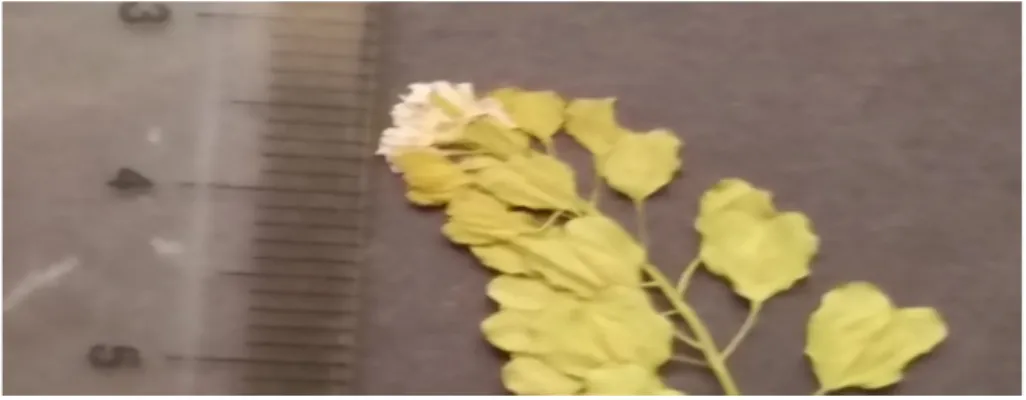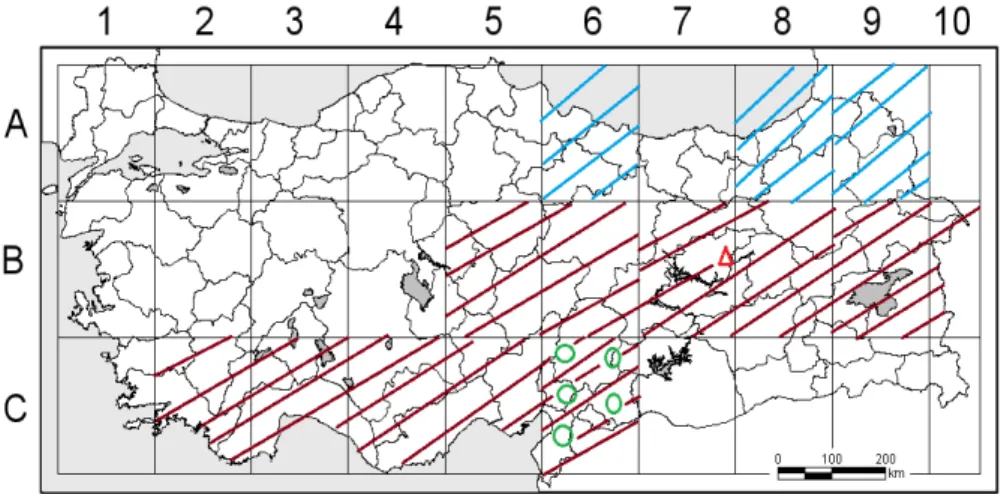Two new species of Fibigia Medik. and Thlaspi L. of
Brassicaceae from Turkey
Şinasi YILDIRIMLI* & Ömer KILIÇ**
*University of Hacettepe, Science of Faculty, Department of Biology Division of Botany 06532 Beytepe-Ankara-Türkiye
ot@hacettepe.edu.tr
**Technical Science Vocational High School, Bingöl University, Bingöl 12000, Turkey
omerkilic77@gmail.com
Abstract
An excursion to Tunceli-Nazimiye from east Turkey in May 2015, we have discovered a new Fibigia and Thlaspi species of Brassicaceae. They are described here as Fibigia yildirimlii Kılıç and Thlaspi kilicii Yıld. based on livings plants and recent herbarium specimens, and are presented theirs a distribution map and closely related species.
Key Words: Fibigia yildirimlii, Thlaspi kilicii, Brassicaceae, Tunceli, Turkey
Türkiye’den Turpgillerin Fibigia and Thlaspi cinslerine ilgin iki yeni tür Özet
Mayıs 2015 yılında doğu Türkiye’nin Tunceli ili Nazimiye ilçesine yapılan bilimsel bir gezide, turpgillerin Fibigia ve Thlaspi cinslerine ilgin iki yeni tür bulduk. Canlı ve yeni otluk örneklerine dayanarak onların betimlemeleri yapıldı ve haritada yayılışları gösterildi ve yakın türleri belirtildi.
Bulduru Sözcükleri: Fibigia yildirimlii, Thlaspi kilicii, Brassicaceae, Tunceli, Türkiye
Introduction
In 2012 Çetin et al. revised the Turkish genus Fibigia Medik. and they described a new section: Purpureae, a new subsp.: F. clypeata (L.) Medik. subsp. clypeata and subsp. anatolica, a new comb. et stat.; F. clypeata (L.) Medik subsp. clypeata var. eriocarpa (1). In fact, F. suffruticosa was transferred to Brachypus genus, B. suffruticosus (Vent.) V. I. Dorof. in Konspekt Fl. Kavkaza 3(2): 411. 2012 (IPNI) (2). Thus, this new section Purpureae is synonym of this new genus of Bracypus.
Brachypus Ledeb.
B. suffruticosus (Vent.) V.I.Dorof., Konspekt Fl. Kavkaza 3(2): 411, 2012.
Syn. sect. nov.: Fibigia Medik., Section: Purpureae A.Duran & Ö.Çetin in African Journal of Biotechnology, 11(1): 110, 2012. Type: Fibigia suffruticosa (Vent.) Sweet, basionym: Lunaria suffruticosa Vent. 1800, Descr. Pl. Nouv.: 19 et tab.
The authors collected interesting Brassicaceae specimens from the Tunceli-Nazimiye of east Turkey during a field trip in the spring of 2015. Already, we have published a new very interesting Aethionema W.T.Aiton Subgenus Hedgeana Yıld. et Kılıç based on Ae. apetalum Yıld. et Kılıç from the same place (3).
After morphological research, these specimens of Fibigia and Thlaspi have been compared to many specimens of related species in the Herbaria of ANK, GAZI and HUB in Ankara and consulting the some numerous relevant literature (4, 5), it was concluded that these specimens of Fibigia and Thlaspi represent as new species to science.
Taxonomic Treatment Brassicaceae
Fibigia yildirimlii Kılıç, sp. nov., figures 1-5
Suffrutescent perennial. Stems c. 20-38 cm x 2 mm, erect, terete, 2/3 leafy, 1/3 frutescence, irregularly patent and adpressed stellate hairy. Steril basal leaves 20-50 x 3-6 mm, oblanceolate-elliptic, petiolate, entire to repand-dentate, attenuate at base, obtuse at apex, conspicous 1-nerved along middle, densely adpressed stellate hairy; stem leaves as basal leaves, slightly decreasing upwards, dense, elliptic, sessile, alternate. Inflorescence spicate. Sepals 5 x 2 mm, elliptic, pale yellow, stellate hairy, scarious margins. Petals 8-10 x 0.6-0.8 mm, yellow, claw 7-8 mm, linear, white scarious; limb 2-3 mm lanceolate, glabrous. Stamens 5 mm, filaments 4 mm, white, winged;
anthers c. 1 mm, pale yellow, basifixed. Styles 1.5 mm, narrowly ovate, 2/3 stellate hairy, 1/3 glabrous, stigma capitate. Pedicels 2-3 mm, erect, stellate hairy. Siliculae c. 7-9 x 4-5 mm, oblong, flattened, 0.5-2 mm long stellate hairy; seeds c. 4-5, c. 0. 5 mm.
Type. Turkey. B7 TUNCELİ: Merkez, Rabat (Çemçeli) köyü alt yolu, kırmızı kayrak taşlık yer, meşe ormanı, 1300 m, 30.05.2015, Ş. Yıldırımlı 41058 & Ö. Kılıç (holo. Yıldırımlı Otluk’u; iso. HUB, Yıldırımlı Otluk’u).
Endemic. Anatolia-Turanian element.
Close to Fibigia eriocarpa (DC.) Boiss. but basal leaves oblanceolate-elliptic (not oblong) and entire to repand-dentate (not dentate); stem leaves elliptic (not linear); filaments winged (not unwinged); siliculae c. 7-9 x 4-5 mm (not 21-24 x 10-12 mm); style 1.5 mm (not 1.5-2.2 mm).
Eponymy. The new species is named in honour of Prof. Dr. Şinasi Yıldırımlı, Hacettepe University, Ankara, Turkey.
Figure 1. Fibigia yildirimlii, habitus, Ş. Yıldırımlı 41058 & Ö. Kılıç (holotype)
Figure 2. Fibigia yildirimlii, habitus, Ş. Yıldırımlı 41058 & Ö. Kılıç (holotype)
Figure 3. Fibigia yildirimlii, habitus, Ş. Yıldırımlı 41058 & Ö. Kılıç (holotype)
Figure 4. Fibigia yildirimlii, infrutescence, Ş. Yıldırımlı 41058 & Ö. Kılıç (holotype)
Figure 5. The distribution of Fibigia yildirimlii and close to Fibigia eriocarpa in Turkey
: Fibigia yildirimlii : Fibigia eriocarpa Thlaspi kilicii Yıld. , sp. nov., figures 6-9
Biennial delicate herb. Root slender. Stems 12-15 cm long including inflorescence, simple, erect, terete to striate, purple at base, yellowish at apex, glabrous, (3-)5(-6) leafy. Basal leaves as rosette-forming, 4-5 x 4 mm excluding petiole, circular, margin entire, shortly petiolate, c. 2 mm, green, glabrous; stem leaves 10-13 x 5-8 mm, oblong, amplexicale, auriculate, obtuse apex, entire, irregularly undulate, glabrous. Inflorescence 2-3 cm, raceme, many flowered, ebracteate. Fruiting pedicels 2-4 mm, 4 mm long below ones and patent, 2 mm above ones and erect-patent. Calyx c. 1 mm, purplish, 1-nerved, whitish margined, glabrous. Corolla 2 mm, white, glabrous. Stamens excerted from calyx, anthers 2 x 2 mm. Siliculae 7 x 3-7 mm, orbicular to obovate, with broadly winged and strongly compressed, reticulate venation, glabrous, emarginate at apex, lobes obtuse, margins red fasciated, entire, wings at sinus 2.5-3.5 mm, septum c. 3-5 x 1.5-2 mm, elliptic to elliptic-obovate, sinus 2-3 mm, style 0.1 mm, insconspicuous. Seeds in each loculus 4-5, c. 1 x 0.3-0.4 mm, scapulate-elliptic, smooth not or insconspicously striate, reddish, glabrous.
B7 TUNCELİ: Nazimiye, Büyükyurt (Hakis) köyü üstü, Şirince ve Sinekli dere çevresi, titrekkavak (Populus tremula) ormanı, kuru dere boyunca, 1850-2000 m, 31.05.2015, Ş. Yıldırımlı 41211 & Ö. Kılıç (holo. Yıldırımlı Otluk’u; iso. HUB, Yıldırımlı Otluk’u).
Close to Thlaspi huetii Boiss. but plant biennial (not annual); basal leaves rosette-forming (not rosette-forming); petals 2 mm ( not 4-6 mm); pedicels 2-4 mm (not 8-14 mm) in fruing time and T. microstylum Boiss. but petals 2 mm ( not 4 mm); sinus 2-3 mm (not 1-1.5 mm), wings at sinus 2.5-3.5 mm (not 1.5-2.5 mm), style 0.1 mm (not 0.5-1 mm), ovules and seeds 4-5 per loculus (not 2) and, T. kotschyanum Boiss. & Hohen. but plant biennial (not annual); basal leaves as rosette-forming (not rosette-forming); stem leaves oblong (not ovate); fruiting pedicels 2-4 mm and patent (not 4-10 mm and ascending); siliculae 3-7 x 3-7 mm, with margins red fasciated (not 10-12 x 10-15 mm), sinus 2-3 mm large (not narrow).
Eponymy. The new species is named in honour of Doç. Dr. Ömer Kılıç, Bingöl University, Bingöl, Turkey.
Figure 6. Thlaspi kilicii, habitus, Ş. Yıldırımlı 41211 & Ö. Kılıç (holotype)
Figure 7. Thlaspi kilicii, inflorescence, Ş. Yıldırımlı 41211 & Ö. Kılıç (holotype)
Figure 8. Thlaspi kilicii, infrutescence, Ş. Yıldırımlı 41211 & Ö. Kılıç (holotype)
Figure 9. The distribution of Thlaspi kilicii, close to Thlaspi huetii, T. microstylum and
T. kotschyanum in Turkey
: Thlaspi kilici : Thlaspi huetii, : Thlaspi microstylum, : Thlaspi kotschyanum
References
1. ÇETİN Ö., DURAN A., MARTİN E., TUŞTAŞ S., A taxonomic study genus
Fibigia (Brassicaceae), Afr. J. of Biotech., 11, 109-119, 2012
2. IPNI (The International Plant Names Index) (2017). Published on the Internet http://www.ipni.org [accessed 2017].
3. YILDIRIMLI Ş., KILIÇ Ö., New infrageneric taxa and species of Aethionema
W.T. Aiton (Brassicaceae) and their current key from Turkey, OT Sistematik
Botanik Dergisi, 23, 1-2, 1-66, 2016.
4. CULLEN J., Fibigia Medik. in Davis P.H. (ed.), Flora of Turkey and the
East Aegean Islands, Edinburgh University Press, Edinburgh, 1, 356-358,
1965.
5. AL-SHEHBAZ I.A., A synopsis of the genus Noccaea (Coluteocarpeae, Brassicaceae), Harvard Papers in Botany, 19, 1, 25–51, 2014.




